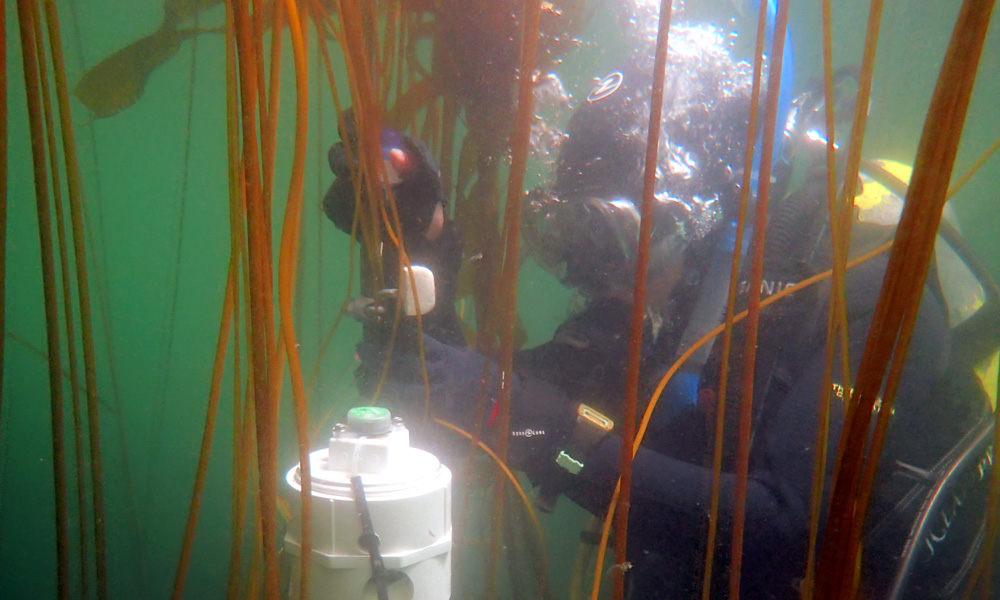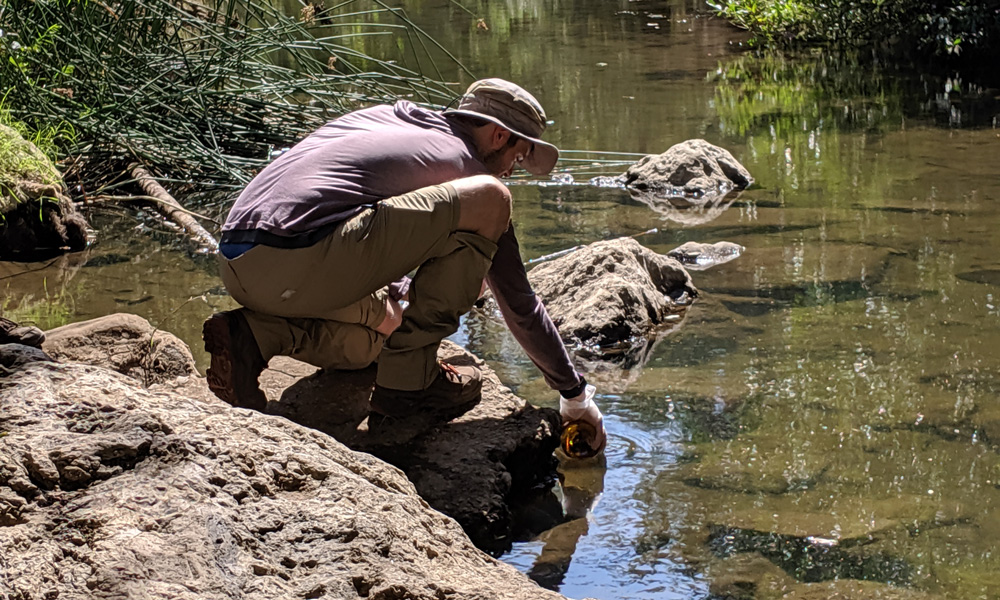The Council on Ocean Affairs, Science and Technology (COAST) integrates resources across the CSU and promotes interdisciplinary multicampus collaborations to advance our knowledge of coastal and marine resources and the processes affecting them. COAST serves faculty and students engaged in marine, coastal and coastal watershed related research at each of the CSU’s 23 campuses and supports research providing innovative solutions to economic, sociological, ecological and technological challenges along our coast.
Ocean Warming, Acidification, Purple Urchins and Bull Kelp

Increasing levels of carbon dioxide (CO2) in the atmosphere from anthropogenic greenhouse gas emissions are raising global temperatures and changing ocean chemistry. Ocean waters are becoming more acidic (increased acidity of seawater is represented by lower pH values), which presents challenges for marine organisms, especially those that build their skeletons and shells out of calcium carbonate (CaCO3). These organisms may have to expend significant amounts of energy to cope with increased water temperatures and ocean acidification, leaving them with less energy for growth, feeding and reproduction. Over time, this can lead to population decreases and subsequent shifts in ecosystem dynamics.
In Northern California, bull kelp is the foundation of highly productive kelp forest ecosystems, providing food and habitat for many economically important marine species and creating hot spots of marine biodiversity. Kelps can affect the chemistry of the seawater around them through photosynthesis and may even be able to reduce the acidity of the water surrounding them. Urchins, one of the major grazers of kelp, have calcareous shells that are sensitive to changes in seawater pH. Recently, Northern California bull kelp forests have been rapidly reduced to unproductive urchin barrens by a multitude of climate-driven events and widespread disease that wiped out many sea stars, the urchins’ main predator. Humboldt State University faculty members Dr. Paul Bourdeau, assistant professor of biological sciences, Dr. Brian Tissot, professor of biological sciences and director of the HSU marine laboratory, and Dr. Eric Bjorkstedt, adjunct professor of fisheries biology, are working together to better understand the dynamic interactions among ocean acidification, bull kelp and purple urchins.
HSU graduate and undergraduate students play a large role in this research. In summer 2018, graduate student Kindall Murie and three HSU undergraduate dive assistants completed 134 dives to characterize spatial variation in kelp and urchin abundance and collected more than 300 water samples in and out of kelp forests at two locations in Northern California. Data collected from this project will form the basis for Murie’s master’s thesis.
The team also has developed a multistressor laboratory mesocosm system that can simultaneously manipulate pH, dissolved oxygen (DO) and temperature to mimic current and predicted future ocean conditions to determine how they may affect urchin grazing on bull kelp. This design and implementation of this mesocosm system has been logistically difficult but has provided HSU graduate and undergraduate students the opportunity to gain valuable experience in circuit schematics and building, computer program coding and experimental design.
Preliminary results indicate that bull kelp can ameliorate local conditions. Even in small, remnant stands of bull kelp, daytime pH and DO were higher in kelp canopies, where photosynthesis primarily occurs, than near the seafloor or in nearby urchin barrens where no kelp was present. These differences were as great as they are in and around large persistent kelp forests off the coast of Washington, demonstrating that even small fragments of bull kelp forest may provide potential refuge from ocean acidification for marine species living in the kelp canopy. This information can help natural resource managers prioritize areas for conservation and restoration efforts to mitigate the local impacts of climate change.
Contaminant Cycling in Coastal Lagoons Systems

Dr. Priya Ganguli and Dr. Scott Hauswirth, assistant professors in geological sciences at California State University, Northridge, are studying the transport and fate of contaminants in ephemeral lagoons that form along the coast where streams meet the ocean. These lagoons receive watershed runoff that is often contaminated with nutrients, metals and sediment. This project was originally intended to assess mercury toxicity in coastal lagoons, which are biological hot spots. Mercury is released into the atmosphere by artisanal and small-scale gold mining and coal combustion, and eventually it settles out on to surface waters or land where it can be washed into lakes, streams and the ocean. Bacteria in low-oxygen environments can transform inorganic mercury into organic methylmercury, a highly potent neurotoxin that builds up in the tissues of fish, shellfish and animals that eat fish, including humans.
The recent wildfires throughout California have demonstrated that fires can impact water quality in coastal watersheds and lagoons as well. The 2018 Woolsey Fire led to an expansion of this study to include polycyclic aromatic hydrocarbons (PAHs), many of which have toxic, mutagenic and/or carcinogenic properties. PAHs form when wood and other organic materials burn and are, therefore, a serious water quality concern in fire-affected watersheds. Additionally, mercury binds to carbon, resulting in direct links between mercury and PAH biogeochemical cycling. Metals and PAHs stick to particles, so any activity that generates sediment runoff will increase the concentration of particle-bound contaminates. Thus, significant post-wildfire erosion can mobilize significant amounts of metals (including mercury) as well as PAHs.
This project focuses on the Malibu Lagoon system in Southern California with the goal of developing an approach to assessing contaminant cycling that can be applied to other West Coast lagoon systems. Beginning in 2012, Malibu Lagoon underwent a massive restoration effort designed to enhance circulation during the dry season when the lagoon forms and tidal exchange with the ocean is diminished or nonexistent. Under these conditions, oxygen levels in the water column and sediment drop to very low levels, which can enhance the production of methylmercury by anaerobic bacteria. Malibu Lagoon is at the outlet of the Malibu Creek watershed, a substantial portion of which burned severely during the Woolsey Fire that ultimately destroyed nearly 100,000 acres.
Dr. Ganguli and Dr. Hauswirth, their collaborators and a contingent of 18 students thus far are using a combination of geochemical, geomorphic and geographic information system (GIS) tools to study mercury and PAH cycling. They have collected water and sediment/soil samples from creeks throughout the watershed and the lagoon during multiple storm events and have analyzed the samples for PAHs and different forms of mercury. Additionally, Dr. Tyler Hughes, assistant professor of political science at CSUN, is evaluating policies around the Malibu Lagoon restoration, which was highly controversial, as well as public perception of environmental health risks, such as exposure to mercury. Dr. Hughes and his students have extended the scope of their work to include analysis of policy decisions regarding wildfire suppression and postfire recovery.
Students are leading different aspects of the project: Christian Hoover, a senior undergraduate, is responsible for the PAH component of the project. Hoover is first author on an international conference abstract, and he presented his findings in December 2019. Erin Schmitt, a graduate student, is currently developing the sampling design to investigate contaminant cycling within Malibu Lagoon itself. This within-lagoon study will be conducted over the next two years. As students step into leadership roles, they also gain valuable mentoring experience and confidence by training new students.
Results to date show increases in PAHs, total mercury and methylmercury in Malibu Creek and its tributaries during and immediately after storm events, especially in upper-watershed locations. Significant increases in PAH concentrations were linked with large storm events, likely caused by precipitation-induced erosion and the resulting increase in sediment loads to surface waters.